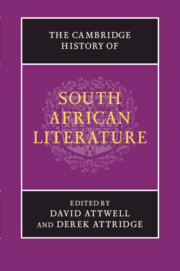Book contents
- Frontmatter
- Introduction
- PART I ORATURES, ORAL HISTORIES, ORIGINS
- PART II EXPLORATION, EARLY MODERNITY AND ENLIGHTENMENT AT THE CAPE, 1488–1820
- PART III EMPIRE, RESISTANCE AND NATIONAL BEGINNINGS, 1820–1910
- PART IV MODERNISM AND TRANSNATIONAL CULTURE, 1910–1948
- PART V APARTHEID AND ITS AFTERMATH, 1948 TO THE PRESENT
- 19 The fabulous fifties: short fiction in English
- 20 Writing in exile
- 21 Afrikaans literature, 1948–1976
- 22 Afrikaans literature after 1976: resistances and repositionings
- 23 The liberal tradition in fiction
- 24 Black Consciousness poetry: writing against apartheid
- 25 Popular forms and the United Democratic Front
- 26 Writing the prison
- 27 Theatre: regulation, resistance and recovery
- 28 The lyric poem during and after apartheid
- 29 Writing and publishing in African languages since 1948
- 30 Writing the interregnum: literature and the demise of apartheid
- 31 Rewriting the nation
- 32 Writing the city after apartheid
- PART VI SOUTH AFRICAN LITERATURE: CONTINUITIES AND CONTRASTS
- Index
- References
26 - Writing the prison
from PART V - APARTHEID AND ITS AFTERMATH, 1948 TO THE PRESENT
Published online by Cambridge University Press: 28 January 2012
- Frontmatter
- Introduction
- PART I ORATURES, ORAL HISTORIES, ORIGINS
- PART II EXPLORATION, EARLY MODERNITY AND ENLIGHTENMENT AT THE CAPE, 1488–1820
- PART III EMPIRE, RESISTANCE AND NATIONAL BEGINNINGS, 1820–1910
- PART IV MODERNISM AND TRANSNATIONAL CULTURE, 1910–1948
- PART V APARTHEID AND ITS AFTERMATH, 1948 TO THE PRESENT
- 19 The fabulous fifties: short fiction in English
- 20 Writing in exile
- 21 Afrikaans literature, 1948–1976
- 22 Afrikaans literature after 1976: resistances and repositionings
- 23 The liberal tradition in fiction
- 24 Black Consciousness poetry: writing against apartheid
- 25 Popular forms and the United Democratic Front
- 26 Writing the prison
- 27 Theatre: regulation, resistance and recovery
- 28 The lyric poem during and after apartheid
- 29 Writing and publishing in African languages since 1948
- 30 Writing the interregnum: literature and the demise of apartheid
- 31 Rewriting the nation
- 32 Writing the city after apartheid
- PART VI SOUTH AFRICAN LITERATURE: CONTINUITIES AND CONTRASTS
- Index
- References
Summary
As a body of work, South African prison literature intersects strongly, but not completely, with the languages of political activism in this country. At least since 1948, with the Nationalist Party's ascension to government, the prison was fundamental to the coercive power of the state. Leaders of resistance movements, artists, writers, intellectuals and rights campaigners were routinely imprisoned, often under the flimsiest of pretexts. Between 1960 and 1990 approximately 80,000 people were detained without trial, in addition to the large number of charged and sentenced political prisoners (Gready, Writing as Resistance, p. 1). When the first democratic cabinet was announced under Nelson Mandela's presidency in 1994, nine of its thirty members had spent time in prison and most had lived in exile at some point to avoid imprisonment.
South Africa's prisons were inescapably part of the national imagination, representing and performing the disproportionate and capricious authority of the government over many aspects of its citizens' public and private lives. In 1996 the South African Constitutional Court moved its headquarters to the old Johannesburg Fort, one of apartheid's most notorious prisons, shrewdly symbolising the displacement of a coercive, brutal state power by a different, more democratic ideal of governance and also underscoring the massive importance of the penal system to the maintenance of apartheid rule. In prison, successive generations of activists defined the nature and form of resistance against apartheid policies, laid down some of the basic coordinates of a democratic nation, interrogated and redefined the nature of citizenry, defined a particular notion of politicised collectivity and raised the complex question of an emergent democratic national identity.
- Type
- Chapter
- Information
- The Cambridge History of South African Literature , pp. 545 - 563Publisher: Cambridge University PressPrint publication year: 2012
References
- 4
- Cited by

